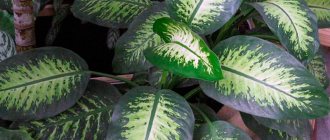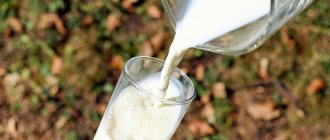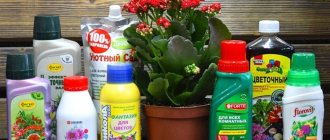How to add shine to the leaves of indoor plants
Both decorative foliage plants and flowering indoor plants look attractive when their leaves are kept clean.
The beautiful glossy shine of healthy leaves indicates both the condition of the plants and the quality of their care. Mandatory procedures for growing indoor crops today often include not only watering, fertilizing, timely replanting and pruning, but also cleaning and polishing the leaves. The latter is designed to give the greenery an attractive shine and perfect appearance. But not every indoor plant needs polishing, and it must be done carefully and following strict rules.
Houseplant treated with leaf polish. © Rhonda Brady
Why do you need “leaf shine”?
Beautiful, shiny leaves today are considered a kind of standard for a well-groomed and healthy plant. And a variety of “magic” products that give foliage a special shine today literally flood the shelves. Advertising recommends them for almost all indoor plants without exception. And at the same time, few people think about the fact that polishing is not necessary for all indoor crops, and for some it can even become a disastrous factor. After all, wax, oil, or polishes with an even more complex composition are, although fashionable, preparations that do not replace good care. And you shouldn’t expect that after spraying a plant with a spray, it will look radically different.
Which plants can be “given shine”?
Among indoor plants there are many species that do not need any cleaning of the leaves and are afraid of any careless contact. Flowering or decorative deciduous crops, whose leaves are not naturally shiny, but are pubescent, velvety, sensitive, openwork, as well as all types of thorny plants, Selaginella, ferns and cacti, do not need polishing in principle.
“Glossing” is possible only for those indoor crops whose leaf surface is smooth, even, shiny, and devoid of the slightest edge. Polishing is suitable for croton, crassula, dieffenbachia, all types of ficus, ivies, palms, philodendrons, monstera, aspidistra, nematanthus and many other flowering and deciduous beauties. But it is absolutely not needed, for example, by Saintpaulias, pelargoniums or begonias.
All means by which you can add additional shine to leaves are divided into two categories:
- Industrial polishes or glosses.
- Homemade polishes.
Industrial preparations for adding shine to leaves
Special purchased liquid or aerosol-type products, called polishes or shine products, are usually not designed for gloss. These are complex preparations with a wide spectrum of action, which have been tested and are the final touch in caring for indoor plants.
Almost every manufacturer of products intended for indoor plants has its own polish. They are sold in the form of an aerosol, a simple spray or a liquid. Such preparations give plants a special shine and a healthy appearance for a long time. And the difference in the appearance of foliage after treatment with a spray or liquid polish is really very strong. The bright gloss and feeling of impeccable condition are very attractive. But behind the visible “shine” lies the most important aspect of their impact: such products, regardless of their form, primarily perform the function of protecting plants from pests and diseases by creating an additional film, or barrier, on the surface of the leaves.
Treating a houseplant with leaf polish. © Rhonda Brady
Liquid and aerosol polishes differ significantly in their effects. Liquid products are used only for plants with large, leathery leaves, such as monstera or rubber ficus, which can then be wiped by hand. Aerosols and sprays are intended for all crops, including those for which manual processing is undesirable - plants with small, delicate, carved or very thick leaves that cannot be rubbed by hand.
Preparations for adding shine to leaves should be used strictly following the manufacturer's instructions, adhering to the methods and methods of application recommended for each specific composition. Be especially strict about the frequency of treatments: if used too often, polishes form an air- and water-proof layer on the leaves, which harms the plants even more than a thick layer of dust. They can be used only in minimal quantities, as rarely as possible, only when it is really necessary to maintain an attractive appearance and protect the plants. In order to avoid mistakes when using such ready-made products to improve the appearance, you should always test on one or more leaves, and then observe for 2-3 days how the plant feels after chemical polishing.
Miracle remedies also have their own precautions:
- Polishes can only be used for plants that are kept in diffused light or shaded lighting. If exposed to direct sunlight, it can cause chemical burns.
- Such preparations cannot be applied to the underside of leaves, shoots, and especially flowers (causes serious developmental disorders, shedding of greenery and serious problems with the health of crops), and also cannot be used for plants that require systemic spraying.
- Before applying the product, you need to clean the leaves from dust and dirt in any convenient way and let the greenery dry.
Cleaning leaves from dust and dirt. © Rhonda Brady Cleaning leaves from dust and dirt. © Rhonda Brady Houseplant leaves treated with leaf glitter. © Rhonda Brady
Store-bought leaf wipes
- In specialized stores, you can choose from an abundance of products for your plants a polish or spray , the properties of which you can ask your sales consultant.
- Among the advantages of store-bought products: they are effective, quickly give the leaves an amazing shine, and have a beneficial effect on the development of plants.
- Among the disadvantages: possible toxicity that accumulates in plants; Besides, store-bought polishes are not cheap.
Purchased product
How to use purchased polishes and sprays for wiping leaves:
- First of all, you need to carefully study the instructions that are given on each package of industrial products. Usually they are either first sprayed onto the fabric, or done directly onto the leaf itself, and then rubbed with a soft cloth until all the leaves begin to shine.
- Immediately after you have processed all the plants you planned, be sure to ventilate the room in which you worked. When carrying out the treatment, use protective equipment (goggles and a mask), and upon completion of the procedure, take a shower and change clothes.
How to wash the leaves of indoor flowers from dust to make them shine?
The procedure is mandatory: we wash away dust and stains from watering or spraying from the leaves of indoor plants. By removing contaminants, including mineral salts, we will ensure normal air exchange for the flower. As people say, “let’s breathe.”
The benefits are colossal: the health of plants improves, they grow and develop faster. Water will wash away pathogenic microorganisms and pest larvae if they have not yet caused significant damage.
In the end, they just look neat and become a decoration for the interior of the house. A flower with clean leaves is more spectacular than a flower that you forgot to wash. I tell you about the procedure and little secrets in detail.
Rules for cleaning plants
Contamination is best seen on large sheets of rich green color. But this does not mean that the rest do not need to be washed!
The frequency of the procedure depends on the location of the flower and your place of residence. A plant placed on a windowsill near a window that is often opened will become dirty faster than one placed in the back of the room. The type of settlement also plays a role: in the city, green pets need to be washed more often.
Watch the plant! Traces of dust and water stains have appeared - why wait for a better opportunity? We have a free minute - let's take care of the rastuski! Moreover, it won’t take much time.
How to clean plants with “fluffy” leaves?
Can violets be washed?
A special word needs to be said about indoor plants whose leaves are covered with villi. These are geraniums, all gesneriaceae (gloxinias, violets, achimenes) and some others. Such flowers cannot be washed regularly - the leaves dry out very poorly (drops are retained by the pubescence), which can cause problems. For example, sunburn or rotting.
At the same time, dust also settles on them, which must be dealt with. From my own experience I will say: maintaining a violet in a decorative form is quite a task! You can remove dust with a soft brush, tilting the plant and brushing away dirt from the center.
But once every 2-3 months you can have a “shower”. But be sure to ensure that the flower dries in a warm and shaded place. Without cold drafts, of course.
Cleaning flowers with large leaves
Detergents cannot be used
It is easiest to wash plants with large leaves: rubber ficus, monstera, dieffenbachia and others. All you need is a soft, damp cloth or sponge.
There are no special requirements for water: the main thing is that it is at room temperature. I recommend using filtered water to avoid getting new stains due to mineral salts and other impurities that tap water is rich in.
But what about those whose leaves are very small?
Be sure to let the water drain afterwards
A great option is to arrange a floral shower. Hold the plants under thin, diffuse streams, preferably covering the soil with film. We are talking about a hot shower that stimulates growth. For cleaning, you can use water at room temperature. A great option is to combine business with pleasure.
“Secret Ingredient” – Natural Polish
Spathiphyllum leaves are very beautiful! Even without flowers
And now - a little advice from personal practice that allows you to make flowers even more beautiful. I actively use it on spathiphyllum and dieffenbachia. After washing, rub the leaves with milk or beer for a gorgeous shine!
Follow the most important and interesting things in the Tatmedia Telegram channel
Gloss for leaves of indoor plants
What does a healthy houseplant look like? Most likely, it has beautiful shiny leaves. This indicator has become a kind of standard for the well-groomed plant. Store shelves are full of miracle products for adding gloss to leaves. But do plants really need polishing, and can all of them be subjected to such a procedure?
CAN ALL HOUSEPLANTS BE GAINED SHINE?
There are many indoor flowers that not only cannot be polished , but even touching them for no reason is undesirable. Firstly, these are flowering plants and decorative foliage crops, the leaves of which do not have a natural shine. They are tender, velvety, pubescent, very sensitive. In addition, ferns, selaginella, saintpaulias, pelargoniums, begonias, cacti and any thorny plants . Dracaena and yucca do not tolerate this procedure well .
Subtleties of ficus care
Ficus is an unpretentious plant, but to make it pleasing to the eye, you need to take care . In addition to light, warmth and watering, this plant likes to be clean. Then it easily grows and attracts attention. Here are some tips for those who want to see beautiful (and therefore clean) ficus leaves .
How to wipe ficus leaves to make them shine?
The easiest way to care for a ficus is to wipe the leaves with a slightly dampened sponge, rag, piece of gauze or velvet, you can even use a soft brush dipped in water. If after such a procedure the leaves remain dull, it means that the problem is not a dusty coating, the problem is inside the body: the ficus wants “feeding”, and it is worth buying fertilizers.
You can look for a special spray for ficus plants in flower shops. After washing, the leaves are sprayed with this product. But there is a big disadvantage: wax is added to the spray, so the leaves will be shiny, but the flower will not breathe. It is not easy to wash off such wax.
To disinfect the plant, you need to add something acidic to the water for wiping the leaves: vinegar (1 tablespoon per 0.5 liter of water), lemon juice or citric acid.
On the forums they say: wipe ficus leaves to make them shine with mayonnaise (dissolve in water, rub, wash off after a couple of days) or milk, which makes the plant grow faster. Using milk or whey (add to water in a 1:1 ratio), gardeners not only achieve the shine of ficus leaves, but also get rid of the white coating on the leaves.
There are people who like to add alcohol, sugar, beer to water for shine, and charcoal to soften the water. Ficus leaves will acquire a beautiful green color if they are wiped with a cloth soaked in black beer.
Of course, wiping every leaf is not a quick task and requires patience. You can speed up this procedure by spraying the leaves with water from a spray bottle with the addition of the above ingredients.
How do you wipe the leaves with a banana?
Some gardeners prefer to polish ficus leaves with banana peels. This provides the plant with additional nutrients and adds shine.
Shower for ficus
Ficus is a living organism, and it also loves to swim. But if large-leaved ficus can still be dealt with manually, then plants with small leaves (ficus Benjamin, fern, dracaena, etc.) are much more difficult to clean. A shower, which many houseplants love, will help here.
When arranging a bath for your green friends, you need to protect the soil from washing out (with film or cloth), monitor the water pressure, which should be very small, and its temperature – no more than 30 degrees. If the ficus is very dirty, then you can use a weak solution of shampoo or baby soap, only after cleansing you need to thoroughly rinse them off the leaves.
A clean and healthy plant is the best decoration for your home interior. We hope that the little tricks you can use to wipe your ficus to make the leaves shine will be useful to you in practice.
Home Recipes
The main disadvantage of all home recipes is their short-lived effect. The main advantage is savings, since some recipes require absolutely no expenses.
Banana peel
After first freeing the banana peel from the long strips, rub the inside of the flower leaves. This natural polish will give a beautiful, well-groomed look to any smooth-leaved plant.
Olive oil
Using a cotton pad soaked in olive oil, rub it over each leaf of your home flower.
Milk
The milk solution creates a thin film on the leaves, which prevents pests from penetrating into the structure of the flower leaves. It is better not to use milk in its pure form.
There are two ways to prepare milk polish:
- Dilute regular cow's milk with water in a 1:1 ratio. Apply to the leaves of a houseplant using a soft cloth or cotton pad.
- Add a few drops of full-fat cow's milk to 1 liter of water. Also use a soft cloth for application.
Egg yolk
Anyone who loves to cook knows that egg yolk gives baked goods an appetizing shine. Same with flowers. To give them gloss, the yolk of a chicken egg must be mixed with water and treated with it on the leaves. In addition to adding shine, this method nourishes plants, since egg yolk is rich in vitamins and beneficial microelements.










